Filters are the main way to group and select assets of interest. Using filters allows you to narrow down your asset selection by certain asset properties. Multiple filters can be applied to identify assets of interest.
You can find the filters in the Assets by Filter option in the Find menu, or in a number of reports in the Reports section.
Drawers
Filters are organised and kept in closed sections called drawers. The drawer system is used throughout the software.
Click any header with a right-facing arrow to open that drawer.

The drawer opens with a list of possible properties of that type. Click the required options for the filter. Sometimes multiple options can be selected.
Selections are green. The more filter selections you make, the more fine-tuned your search will be.
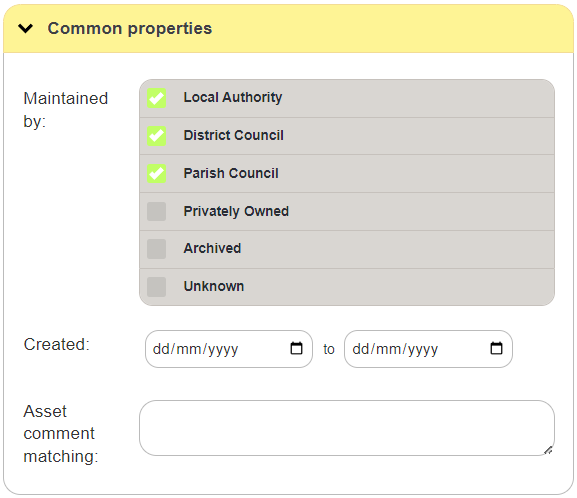
Finding Assets by Filter
Click Assets by filter to find assets using Grass SMART's filters.

Select the required asset types.
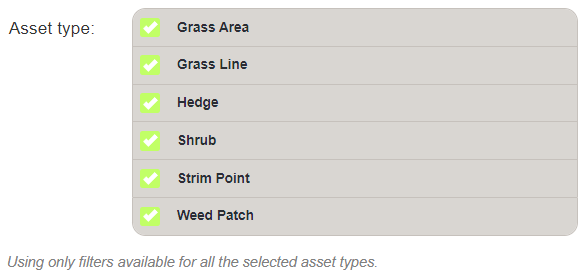
All types begin selected. Click the unwanted asset types to deselect them.
Having multiple options selected will only display filters for all selected asset types.
Note: Filtering is only possible on all shared characteristics of the asset types selected; e.g. if both Grass Areas and Strim Points are selected, there will be only filter options common to both grass and strim points. You will not be able to filter by Strim Type because that is not an available attribute on grass areas.
Common Properties
Click Common Properties to specify ownership, programmed cut date, etc.

Common properties include information on responsibility for maintenance, including archived and unkown, and creation dates. This enables users to identify assets maintained or owned by third parties as opposed to those maintained by the local authority.

For example, selecting Local Authority in the Maintained by filter would return all assets that are maintained by the local authority. This would exclude assets that are maintained by other council units, third parties, or assets that have been archived.
Created filters by the date the asset was created in the system. By limiting assets to creation dates, you can also identify assets that have been added by your crews to differentiate them from assets which were imported at system launch.
You can also search by comments left by users on the assets.
Location
Click Location to specify the local area, road properties, etc.
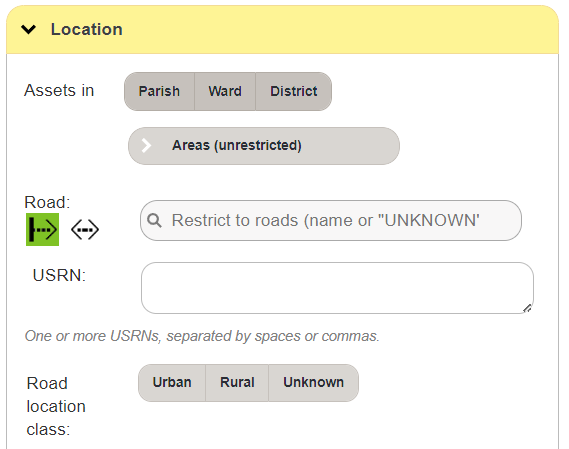
The combination of an asset type with a location filter will first limit the search to the selected asset type, and then only to assets in the location selected. Each selected filter will in turn narrow the search down into an ever-smaller subset of the original data determined by each filter selected.
In this way, you can use the filters to search for all assets of a single type, in a single ward, which are on A roads. This would allow you to plan out traffic management or out-of-hours visits to minimise traffic disruption.
Note: Do not include conflicting requests in multiple filters as some filter selections may cancel each other out.
An example of this is the Road Classification/Hierarchy and Road Form Filters. If you were to select Road Classification as Motorway, but then set the Road form to Footpath, you would expect to receive 0 results as the selections conflict with each other.
To search for assets within a specific area on the map, click polygon or rectangle to choose the area shape. Instructions are given on how to draw the polygon or rectangle area.
Click Restrict location on map... to start drawing the area. Follow the instructions given.

Using the Restrict location on Map filter allows you to draw either a polygon or rectangle on the map and only assets within that area will return in the asset results. This is useful for either large areas that do not conform to other area filters such as housing estates, or for smaller areas such as road junctions or parks.
Click Clear restriction to dismiss your drawn selection.
Access
Click Access to search using access and traffic management information.
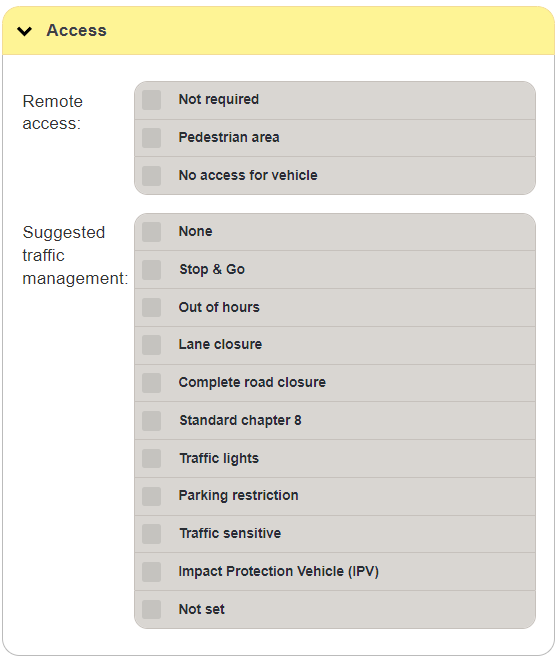
Suggested traffic management is any recommended regulation of traffic during asset inspections or work due to its location.
Cycle Properties
Click Cycle properties to locate assets on the selected maintenance cycles.
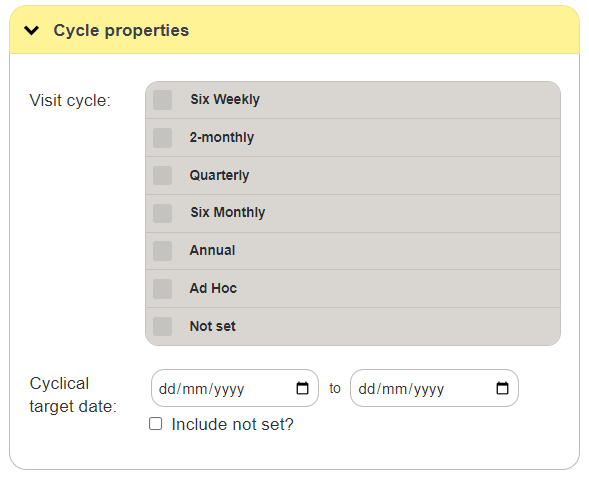
You can also set a range of due dates to return assets that are due to be visited within that date range. By checking the Include not set? box you will extend the search to assets which do not have a due date set.
You can use any combination of these filters, or use each one on its own, depending on your needs. They are not dependent on each other.
Last Inspection Visit
Click Last inspection visit to filter by details of the most recent inspection.
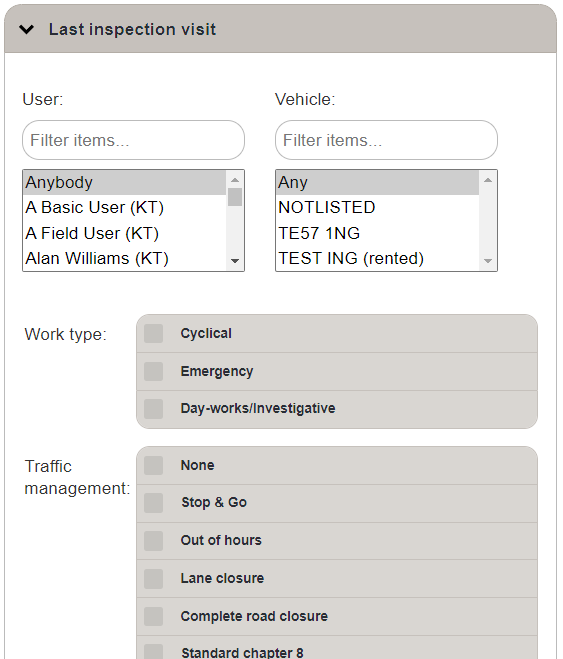
This allows you to find assets where certain values were recorded, such as drainage assets that had high silt levels on their last visit.
Other filters in this drawer include:
- User - The user recorded against the inspection.
- Vehicle - The vehicle registration selected by that user on login.
- Work Type - Cyclical or reactive work.
- Grass length - The length of the grass before the cut was performed
- Cut -Whether or not the asset was cut at the time of the visit.
- Obstruction - If the cut was obstructed by parked cars, flytipping etc.
There may be many more according to the bespoke configuration of your system.
Work Requests
Click Work Requests to specify requested work by type, status, priority etc.

If your system supports Service Requests, you can filter assets by the request type and their status. The status of a Service Request is either open, fulfilled or abandoned. This allows you to package together similar tasks into work packages, for example.
You can narrow the results down to those raised or resolved by specific users, and specify date ranges on when the request was opened, due by, or resolved.
Due dates are dependent on a priority having been set in supporting systems.
Resolved by is used for identifying requests that have been fulfilled or abandoned between certain dates.
Using an Asset ID
Instead of using filters, you can enter the Asset ID to locate an asset. Click Asset ID to specify the ID.

Enter multiple IDs by separating them with commas, spaces, or each asset on a separate line. Do not combine the methods. The following example would fail as the asset IDs are separated by a comma and a space.

Note: When using asset IDs, check all your previous filter selections. Assets will only be returned if they match ALL filters, including the asset ID. If one or more of the asset IDs do not match all other filters set, they will not be returned in the results.

- Click Save as Work Package to use the selected assets in a new package of work.
- Click Clear to clear the filters to start again.
- Click Report to open the resulting assets in a state report page with the selected filters.
- Click Show to show the selected assets on the map.
